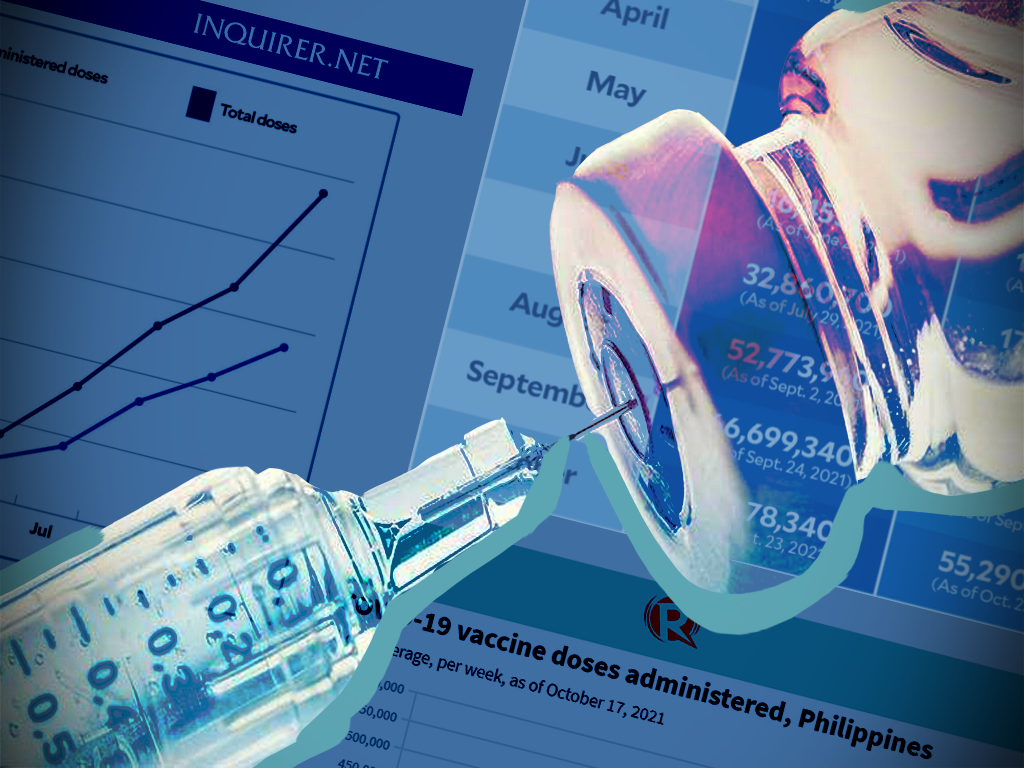Inquirer.net and Rappler zoom in on slow vaccination pace
CHEERS TO Inquirer.net and Rappler for their explanatory reports on the slowdown of the vaccination program, after the media had echoed official announcements about how the government had secured enough supplies. Finally, it seemed that the vaccine effort would now move forward enough to achieve vaccine coverage targets. But the two news organizations both checked the situation on the ground and noted other problems confronting the program.
“After peaking with an average of 523,018 doses administered daily in one week during the start of August, the number of vaccine weekly inoculations has dwindled to 375,773 daily as of October 17,” Rappler stated in its report on October 21. Further, Inquirer.net said on October 25 that Bantay Bakuna, a multi-sectoral group tracking the vaccination rate, estimated that “to reach the target of 70% of the population by December, the average should be at least 1,448,438 doses a day nationwide.”
The use of graphics in both reports helped establish how much the government has to do to get the vaccine to the people now that supply is no longer a problem.
Rappler‘s Sofia Tomacruz highlighted how the government has failed to deliver on its claims that it will speed up vaccination: “Experts had anticipated and warned the government of the need to improve how vaccines were received and administered because the bulk of orders were scheduled to arrive in the Philippines by late 2021 or early 2022. The government was unprepared to launch the COVID-19 vaccination drive, the largest inoculation program the country has had to mount.”
Tomacruz also pointed out that the main factors were logistical challenges such as deployment and distribution of vaccines and continued vaccine hesitancy, as people continue to be concerned about the safety of the vaccine and the vaccination sites.
Meanwhile, Inquirer’s Kurt Dela Peña cited other sources tracking the vaccination rate, which also reported the inadequacies and inefficiencies of the program. Dr. Jamie Dasmariñas of Bantay Bakuna said that “a national program to protect Filipinos against COVID-19 should have been prepared ahead, especially because it was devolved.”
Further, Dasmariñas also noted some services that should have been strengthened, in particular by hiring more health care, data, and logistics workers. “Instead of outsourcing health care workers through private institutions, the government should increase plantilla and hire health workers centrally through the Department of Health to help local governments,” she added. Inquirer also pointed the limited access to online registration system for vaccine schedules, citing the Department of Information and Communications Technology’s data that “only 17.7% of households have internet access.”
Dela Peña also used charts to show how the inoculation rate has not kept up with available supplies. His charts showed the herd immunity target, the record of total doses received for a month, and the total roses administered since March 2021.
Media have reported that the government plans to vaccinate more children and members of the general population, and to give health workers, seniors and immune-compromised individuals a third dose. But, except for those of Rappler and the Inquirer, no reports checked how quickly and capably LGUs have stepped up to the challenge of implementing this massive program.
IATF is not off the hook just because it has authorized LGUs to conduct the service on their own. Part of their responsibility is to make sure the authorized agencies have been trained and prepared to do their part. If the LGUs fail, the IATF bears the burden of responsibility for failing to check capacity as well as to step in and take charge.
Media coverage should do what it can to check on how the government is performing over all to achieve its policy goals. It is not enough to simply report official statements, because without the media verifying what is really going on, such statements come off only as propaganda. Journalists should have asked right off what has been done to prepare the LGUs to do what they have to do, as media know well enough that LGUs differ from one another in their commitment and capacity to serve the public. Media spot checks in various areas would have gone a long way in making sure that no LGU is falling behind in vaccinating their constituencies.
To trumpet the goal and not follow up on its actual accomplishment misleads the public into thinking that vaccination is already a done deal and that it no longer has to fear being infected with the COVID-19 virus.

Leave a Reply